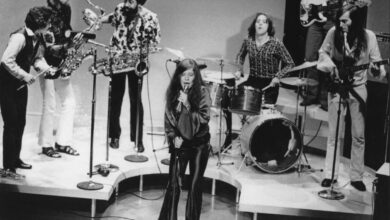The Browns’ “The Three Bells” Echoes Through Time as a 1959 Country and Pop Landmark
In 1959, The Three Bells by The Browns emerged as a deeply moving ballad that bridged the worlds of country, pop, and gospel, becoming one of the most unexpected crossover hits of the era. Originally a French song titled Les Trois Cloches, its adaptation into English gave American audiences a heartfelt narrative that followed a man named Jimmy Brown through the defining moments of his life. With its touching lyrics, rich harmonies, and spiritual undertones, the song resonated across generations, reaching No. 1 on both the Billboard Hot 100 and Hot Country Songs charts. Few country songs had achieved such mainstream success at the time, and The Three Bells helped redefine the genre’s place in popular music.
The Browns—a sibling trio consisting of Jim Ed, Maxine, and Bonnie Brown—were originally from Sparkman, Arkansas. They started their musical journey in the early 1950s, blending folk, gospel, and country influences to create a smooth, harmony-driven sound. While Jim Ed had initially pursued a solo career, his sisters soon joined him, forming a family act that stood apart from the honky-tonk and rockabilly trends dominating country radio. Their soft, melodic approach provided a contrast to the era’s more rambunctious styles, making them a unique presence in the Nashville music scene.
The song itself had origins far from the American South. Les Trois Cloches was composed in 1945 by Jean Villard and originally performed by French singer Édith Piaf with Les Compagnons de la Chanson. It was a widely recognized European hit, known for its deeply sentimental and religious themes. The English version, adapted by Bert Reisfeld, preserved the song’s core message but framed it within a more distinctly American small-town setting. The storyline followed Jimmy Brown from his birth to his wedding and finally to his funeral, with church bells marking each of these significant life events. The universal themes of faith, community, and the passage of time gave the song a near-spiritual resonance, making it relatable to audiences of all backgrounds.
The recording was produced by Chet Atkins, a visionary figure in country music whose influence helped shape the “Nashville Sound.” Atkins kept the arrangement simple and elegant, allowing the trio’s harmonies to take center stage. The result was a warm, ethereal sound that blurred the lines between country and pop, appealing to audiences beyond traditional country listeners. Jim Ed Brown’s smooth lead vocal carried the song’s emotional weight, while Maxine and Bonnie’s harmonies wrapped around him like a comforting embrace, reinforcing the song’s themes of love, loss, and continuity.
Upon its release, The Three Bells quickly soared up the charts, spending ten weeks on the Billboard Hot 100 and becoming a million-seller. Its ability to top both the country and pop charts was a rarity at the time, marking The Browns as pioneers of crossover success. This achievement was especially significant in an era when country music was still largely confined to regional radio stations. The song’s ability to resonate with mainstream listeners helped break down barriers for future country-pop artists, paving the way for figures like Patsy Cline and Glen Campbell, who would later achieve similar crossover appeal.
Beyond its chart performance, The Three Bells had a cultural impact that extended beyond music. It became a favorite at weddings, funerals, and church services, reinforcing its reputation as a song of life’s milestones. Its presence in the American musical landscape was further solidified when it was performed on The Ed Sullivan Show, a key platform for artists looking to reach national audiences. At a time when television was becoming a dominant force in shaping musical trends, The Browns’ appearance helped them connect with viewers across the country.
For The Browns, The Three Bells was a career-defining moment. While they had previously found moderate success with other recordings, this song propelled them to a level of fame they had never experienced before. The trio began touring extensively, sharing the stage with country legends and mainstream pop acts alike. However, their crossover success also made them something of an anomaly in country music. While Nashville appreciated their success, their smooth, almost choral style was different from the honky-tonk and emerging rock-influenced sounds of the time.
Despite this, their influence on the country genre was undeniable. The Three Bells helped cement the idea that country artists could reach broader audiences without losing their authenticity. It also reinforced the importance of tight harmonies in country music, inspiring later groups like The Statler Brothers and The Oak Ridge Boys. The song’s storytelling approach, focusing on a single character’s journey through life, also became a blueprint for narrative-driven songwriting in the genre.
Over the years, The Three Bells has been covered by numerous artists, including Roy Orbison and Emmylou Harris, who recorded her own version in the 1980s. While each rendition brought slight variations in tone and arrangement, none quite captured the delicate beauty of The Browns’ original. Their version remains the definitive recording, standing as a testament to the power of simplicity and sincerity in music.
At the time of the song’s success, America was going through a period of cultural transformation. The late 1950s marked the rise of rock and roll, but The Three Bells proved that there was still room for introspective, sentimental ballads. Its themes of faith, family, and the cycle of life resonated deeply with listeners looking for stability in a rapidly changing world.
Decades later, The Three Bells continues to be a fixture in classic country playlists and radio programs. Its longevity speaks to its universal themes and the purity of its harmonies, which remain as moving today as they were in 1959. The song’s ability to evoke deep emotions ensures its continued relevance, particularly during moments of personal reflection and life’s major transitions.
The Browns were inducted into the Country Music Hall of Fame in 2015, a long-overdue recognition of their contribution to the genre. While they had other successful songs, The Three Bells remains their most iconic recording. It captured a moment in time when country and pop could seamlessly blend, proving that heartfelt storytelling transcends genre boundaries.
More than sixty years after its release, The Three Bells stands as a timeless reminder of music’s ability to touch the soul. Whether heard in a church, on the radio, or in a quiet moment of remembrance, its message endures—reminding us all that life, love, and memory are forever intertwined, just like the ringing of distant bells.



